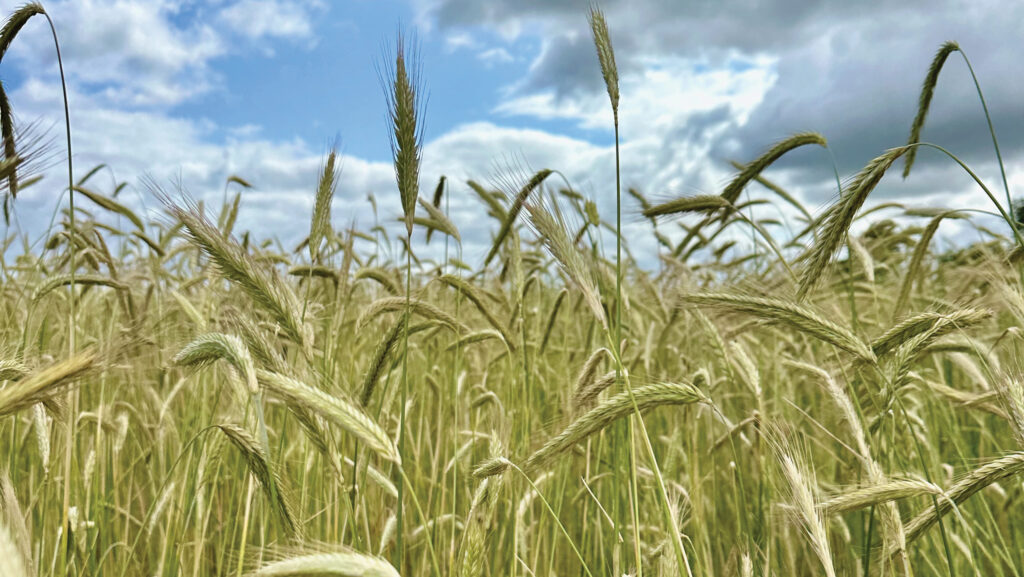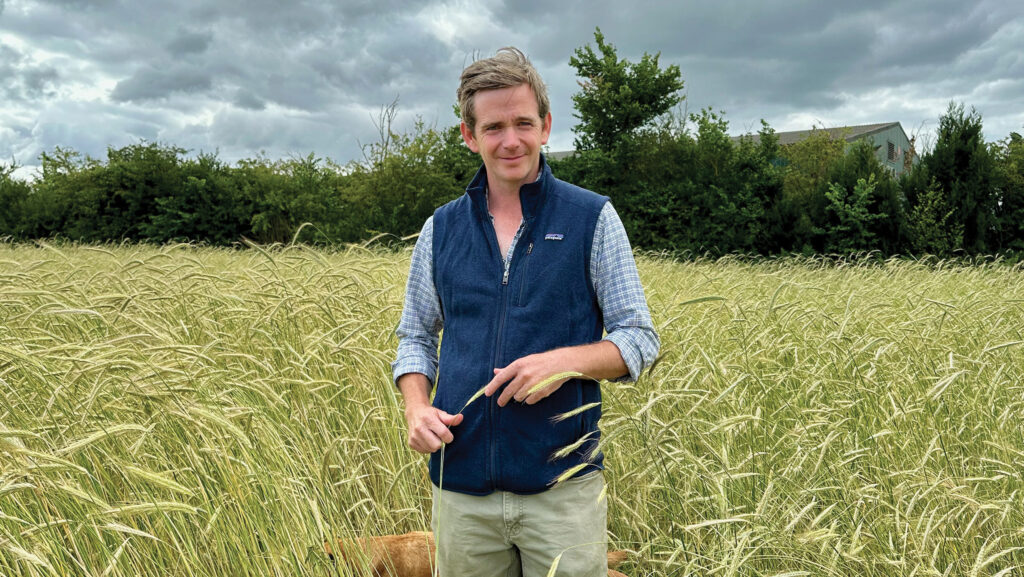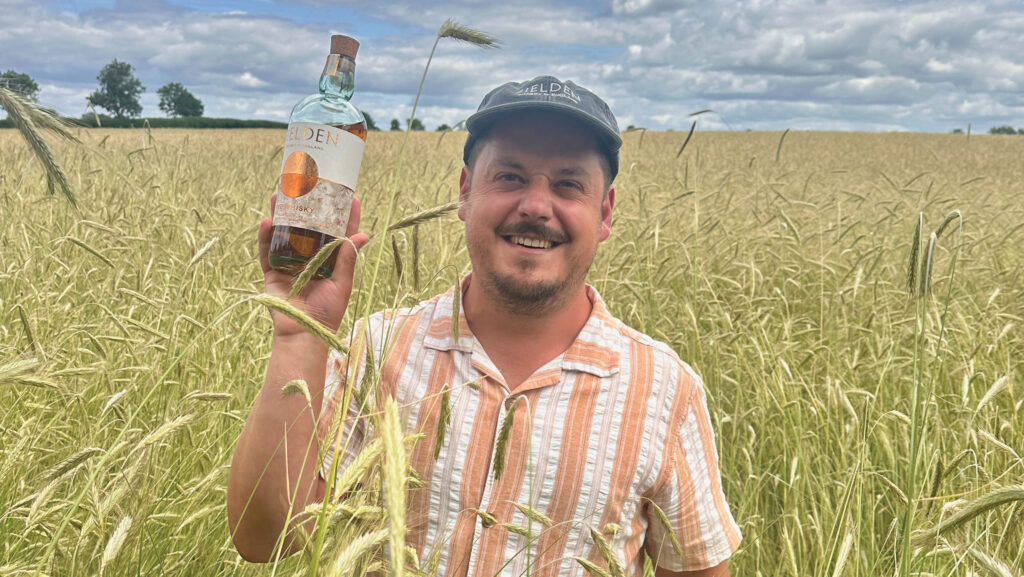How heritage rye is used to produce regen premium whisky
 Heritage rye © Mike Abram
Heritage rye © Mike Abram A startup firm is delving into English whisky making, which is a relatively rare concept, and its core product is rarer still – rye whisky.
Fielden regen whisky has a relationship with farmers which makes it a little different.
It runs an unusual contract to mirror some of it’s relatively unusual rules and restrictions when it comes to crop agronomy.
See also: Why one Scottish light land estate has opted to grow rye
It’s also unusual to have a whisky brand that’s not named after where its distillery is located, says Dave Smith, the firm’s chief executive.
“Fielden is an old English word for field,” he explains. “And our brand is all about the field and the farmers we work with.”
Hugh Forsyth from Tubbs End Farm, Kineton, in Warwickshire, is head of farming for Fielden, as well as one of 18 farmers currently growing a total of 360ha of heritage rye this season for the firm.
He manages the supply of the seed and acts as the central hub for all the grain produced.
On his own 1,600ha farm, which is a mixture of owned and contracted land, he is growing about 160ha for Fielden this season.
The whole farm is farmed either organically or using regenerative farming principles, which fits in with the ethos that Fielden is looking for with its production.
The rules that are an even stricter version of what Wildfarmed specifies for its cereal crops.
Specifically, it insists that no pesticides of any type are used when growing the crop.
This includes not using any pre-drilling herbicide, such as glyphosate, or applying any artificial fertiliser.
“We’re trying to find a viable yield in the field, to allow us to not use agrichemicals,” Dave says. “And also produce a grain that works through a floor malting process and into a distilling process.
“It’s quite a challenge to work with and not against nature to deliver those aims.”
Heritage varieties
The seed is from a population of heritage rye varieties sourced from Denmark.
“There are hundreds of different rye varieties growing in the field
“This gives it an advantage fighting diseases and pests, and coping with whatever the weather or environment throws at it.
“Whether it is wet or dry, there’s always something that will thrive,” says Hugh.

Hugh Forsyth © Mike Abram
Yields are much lower than in conventionally produced cereal crops.
“Heritage grains are built for flavour rather than yield.”
This season’s crop yielded 1.9t/ha, he says.“I’m happy with that considering we had no rain during the growing season.”
In some years, yields have been as low as 0.75t/ha, while in the best year he’s achieved 4.25t/ha.
Yield matters little for the farmer, as Fielden pay on an area basis regardless of what’s produced.
“So we don’t pay by yield. This type of farming is experimental and can lead to significant amounts of failure.
“We don’t hide from that and learn from it. That’s why we are paying £1,250/ha to underwrite them commercially,” explains Dave.
In addition, payments from Sustainable Farming Incentive options can be stacked on top.
That potentially includes payments for growing low-input cereals, using inter-row hoeing and, if grown as a spring crop, an overwintered cover crop, which could be worth up to £644/ha in total.
While that funding doesn’t materially affect the profitability of growing for Fielden, it does help with reinvestment in the business, Hugh says.
Establishment
Ideally, the rye crops should be drilled in September – although on Hugh’s farm, 200mm of rain in two days put paid to that plan this season.
Instead, it was drilled in the first week of October, after a light cultivation to remove volunteers from a previous heritage barley crop.
That cultivation also disturbed the understorey of small-leaved white clover in the field, which, ideally, Fielden would like growers to establish to help provide nutrition and weed suppression for the crop.
“Some of the clover did grow back, but we didn’t have enough from the previous year.
“So we planted some more in the spring at the same time as pulling a harrow through to pull a few weeds out.
“Usually, you wouldn’t need to harrow as the clover and rye outcompete most weeds,” Hugh says.
“But if the clover doesn’t grow, then you might need to resort to good old-fashioned hoeing and harrowing to suppress grassweeds.
“Adding no synthetic fertiliser also helps reduce weed pressure.
“You’re not feeding those weeds, so even if they produce seed heads, they are much smaller.”
Successfully establishing a clover understorey is a challenge, he admits. “Growing one crop is hard enough, growing two together is harder again.”
The key is picking the right time to establish, with Fielden growers having both success and failure in spring and autumn.
“It’s really a decision at the time, and depends on weather and soil type.”
In-season management
Management of the crop in-season is very straightforward, given no inputs can be applied. Grazing is allowed, however.
“That works well from January through to early March,” Hugh says. “Rye starts growing away quite early in the spring, so you want to get the sheep off by then.”
Grazing helps remove any diseased leaves, encourages tillering and provides fertility, he says.
There is also a second opportunity to graze the clover post-harvest. “If you graze it hard enough, you can direct-drill the next rye crop.”
Where livestock are not available, a light cultivation might be required before drilling the next crop.
“We try to keep rye in the same field as long as we can – it doesn’t suffer from take-all and volunteers are not an issue.
“If we think we need a break, we can grow a spring heritage wheat or barley.
“But growing continuous rye keeps it simple for our farmers, as long as the understorey is managed well.”
Malting
Post-harvest the grain is dried to 14% at Hugh’s farm.
It is cleaned, if necessary, using a colour sorter until it is ready to send to be batch malted, depending on recipe, at Warminster Maltings or sent directly to Adnams for distilling to Fielden’s specification.
The aim, which sits alongside Fielden’s core tenets of growing fields full of life and keeping farmers’ happy, is to produce a whisky full of flavour, which the firm sells as a premium product costing around £60/bottle.
“We don’t do what a lot of other whisky makers do in taking a conventional grain, using a conventional distilling process and a uniform post-maturation process so you know exactly what you will get out.
“We have variability from the grain and that goes through the floor malting and distilling.

Chico Rosa © Mike Abram
“The cask programme might have some uniformity to begin with, but our whisky maker, Chico Rosa, has a penchant for sweet European wine casks.
“This brings a sweetness to the normal peppery spice that we find in rye whisky.”
The standard Fielden rye whisky aims for a consistent flavour profile by blending spirits from different years and recipes, which acts as a buffer to the natural variability that comes from farming, Chico explains.
A lot of experimentation was needed to get to that stage, with the initial years of Fielden, when the firm was trading as the Oxford Artisan Distillery, building up an inventory of different editions from different casks, blends and approaches.
“At the beginning we didn’t know what to expect from our grain,” he says.
“So the first time we started to distil, we were surprised because the spirit had caramel and butterscotch flavours, which has become our signature flavour.”
Ultimately, the experimentation has resulted in a whisky that is matured for around four years in a combination of old and new American oak casks, and small amounts of sweet wine casks.
Whisky range
The standard whisky is accompanied by a range branded as “Harvest”, which is whisky produced from a particular harvest year.
The distilling and maturation process is kept similar, which means flavour differs according to the grain.
For example, harvest 2019 was characterised by the challenging growing year, with a dry spring followed by a wet and cooler harvest and some green harvested grain.
“The whisky was spicier, as the rye notes are more pronounced.
In contrast, harvest 2020 saw a hot, sunny summer, resulting in fully ripe grain.
The result was a nuttier, smoother whisky, Chico concludes.

